the only triple-axis flying tourbillon wristwatch... in the world ;)
[tip of the hat to clarkson there...& if u dun get it, pay it no mind :)] so a couple of months back, i had the good fortune of taking pics of some interesting time machines... i received the press release of one such machine today and thought to share some pics... and some information from that press release below
RAPHMEISTER INSTRUCTIONS... download the following 5 pics to your PC and save them in one folder and play it on super high speed slideshow(or click thru it quickly) and you have a bit of twirling goin on :) sorry folks i dun have a usable video of it
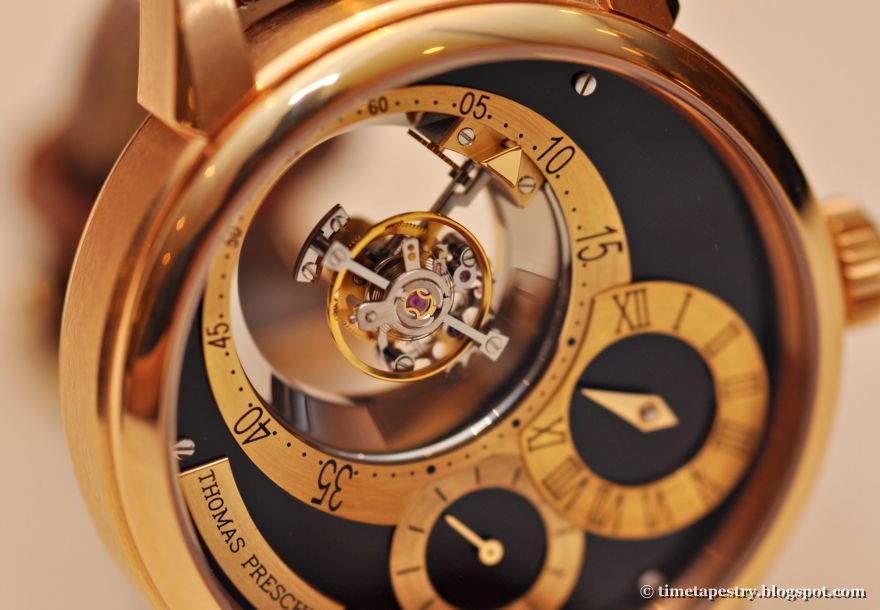

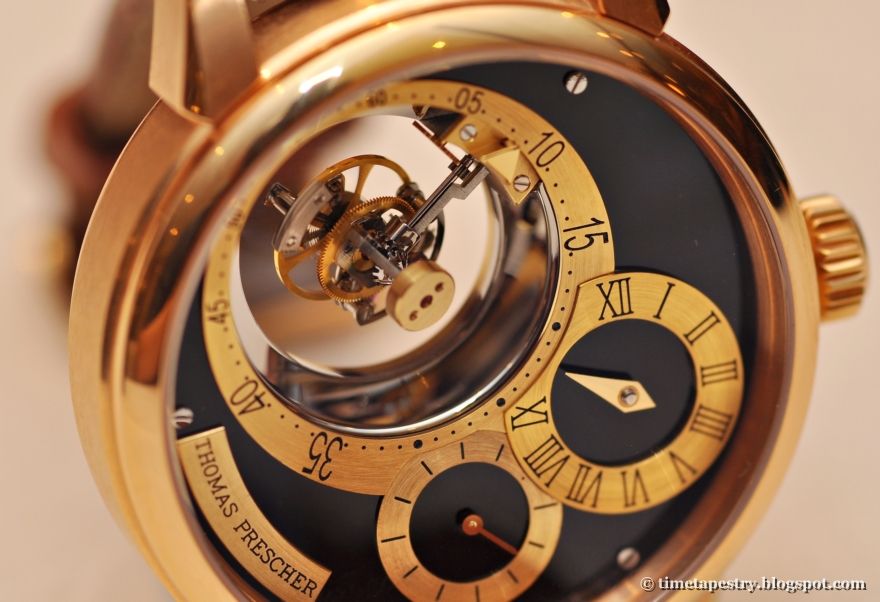
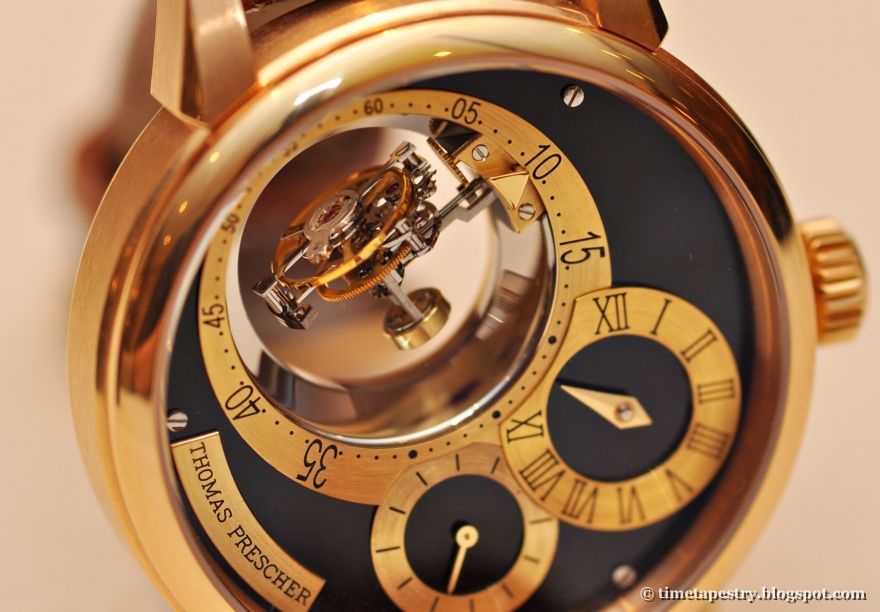
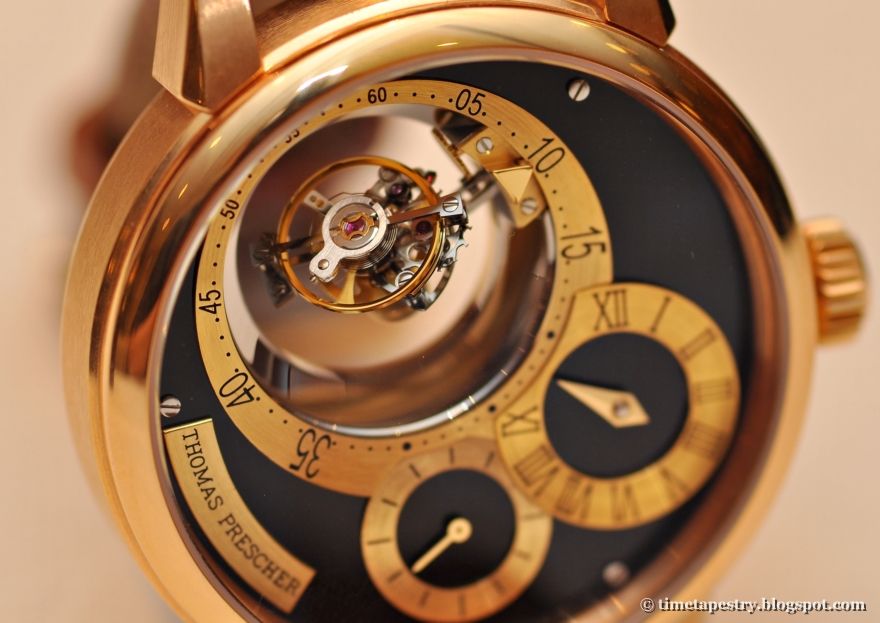
Why a flying tourbillon?
A normal tourbillon is supported by bridges top and bottom that obstruct a clear view into the tourbillon. Although much more difficult to achieve, Thomas Prescher chose to make his triple-axis tourbillon fully flying, i.e. supported by just one side so that very little impedes visual access to the kinetic ballet of the triple-axis tourbillon.
Further ensuring that absolutely nothing diminishes the pleasure of enjoying the tourbillon in all its beauty, the complex and intricate triple-axis tourbillon mechanism is driven via two conical gears instead of the easier gear-to-gear solution. Thomas Prescher was the first, and is still the only watchmaker to use this system.
The difficulty in supporting anything by just one end is balance. When an object is supported on two sides its equilibrium is not as critical as if it is supported on only one. However, imagine balancing an object moving through not one, not two, but three different planes!
A normal tourbillon is supported by bridges top and bottom that obstruct a clear view into the tourbillon. Although much more difficult to achieve, Thomas Prescher chose to make his triple-axis tourbillon fully flying, i.e. supported by just one side so that very little impedes visual access to the kinetic ballet of the triple-axis tourbillon.
Further ensuring that absolutely nothing diminishes the pleasure of enjoying the tourbillon in all its beauty, the complex and intricate triple-axis tourbillon mechanism is driven via two conical gears instead of the easier gear-to-gear solution. Thomas Prescher was the first, and is still the only watchmaker to use this system.
The difficulty in supporting anything by just one end is balance. When an object is supported on two sides its equilibrium is not as critical as if it is supported on only one. However, imagine balancing an object moving through not one, not two, but three different planes!
[ click to read the rest of the post... expand or collapse ]
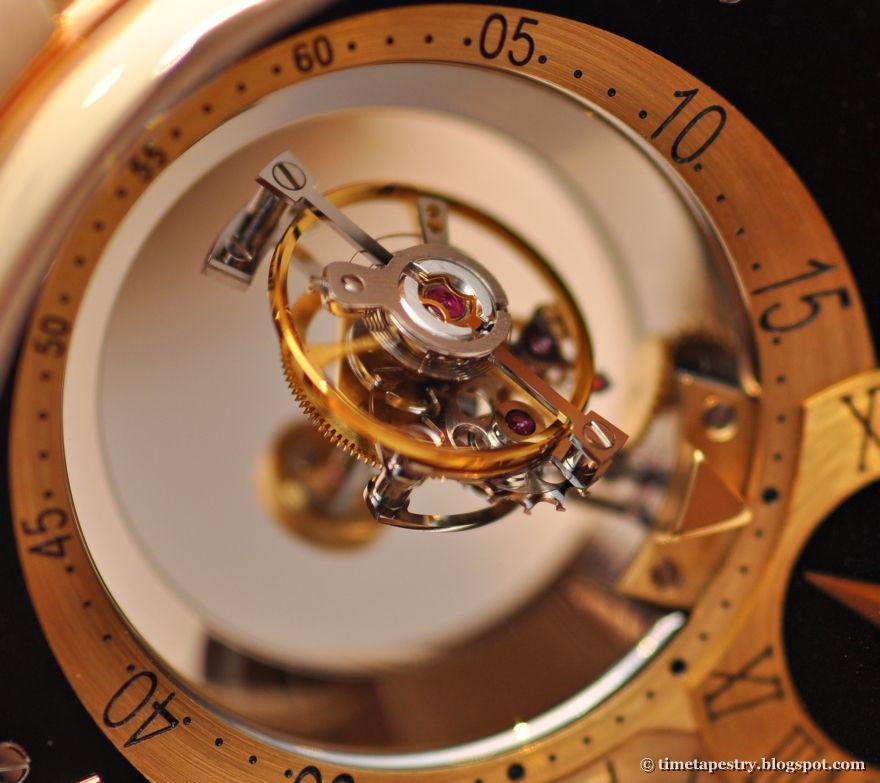
Constant-force mechanism
While the triple-axis tourbillon mechanism, which includes the escapement wheel, pallets, anchor, balance spring and balance wheel, is extremely light in weight – the smallest screw is less than 1/1000th of a gram – it is actually heavy in relation to the amount of energy available. One of the major issues regarding multi-axis tourbillons is ensuring an ample supply of power to the escapement, the mechanism that regulates timekeeping.
To resolve this problem, Prescher has added a constant-force device inside the tourbillon cage turning around the first axis. This device transmits energy directly to the escapement six times per second, i.e. with every beat of the oscillating balance. The main power train drives the tourbillon and recharges the constant-force spring so that it always has sufficient power on tap for the escapement. The "Jeanneret" constant-force system used requires no energy-sapping levers, but works efficiently using the different inertias of the escapement wheel and tourbillon carriage.
While the triple-axis tourbillon mechanism, which includes the escapement wheel, pallets, anchor, balance spring and balance wheel, is extremely light in weight – the smallest screw is less than 1/1000th of a gram – it is actually heavy in relation to the amount of energy available. One of the major issues regarding multi-axis tourbillons is ensuring an ample supply of power to the escapement, the mechanism that regulates timekeeping.
To resolve this problem, Prescher has added a constant-force device inside the tourbillon cage turning around the first axis. This device transmits energy directly to the escapement six times per second, i.e. with every beat of the oscillating balance. The main power train drives the tourbillon and recharges the constant-force spring so that it always has sufficient power on tap for the escapement. The "Jeanneret" constant-force system used requires no energy-sapping levers, but works efficiently using the different inertias of the escapement wheel and tourbillon carriage.
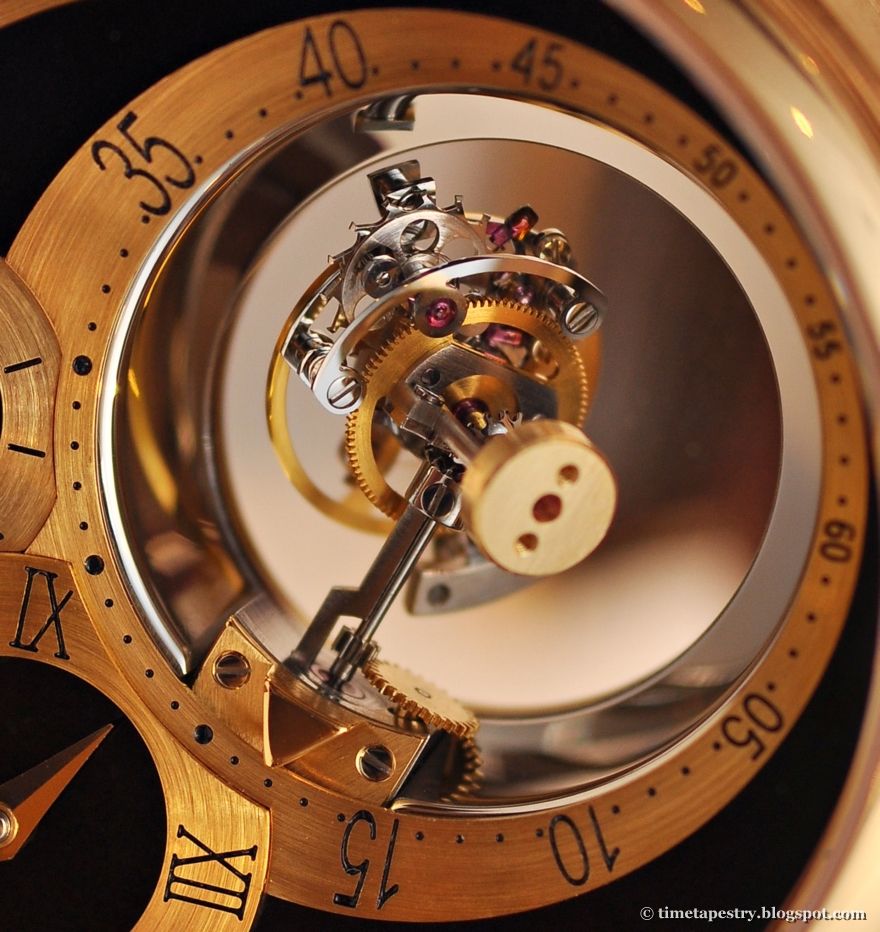
Technical Specifications
Triple Axis Tourbillon Regulator. Calibre TP 3W6A.3; mechanical hand-winding indicating hours, minutes and seconds; flying tourbillon with constant-force in carriage; tourbillon flying on all axes; tourbillon with shock protection.
Calibre TP 3W6A.3
Power reserve: 40 hours
Balance frequency: 21’600 bph/3hz
Smallest screw: 0.0009 grams
Tourbillon, constant-force mechanism and oscillator
Tourbillon rotation height: 12.2mm
Full revolution: 1st axis one minute, 2nd axis one minute, 3rd axis 60 minutes
Constant-force mechanism: positioned in the tourbillon cage
Constant-force system: Jeanneret's inertia acceleration
Constant-force loading: 6 times per second
Diameter of balance wheel: 9.5mm
Diameter of tourbillon cage: 13.4mm
Weight of tourbillon 1st axis: 0.347 grams
Weight of 1st and 2nd axis: 0.766 grams
Weight of 1st, 2nd and 3rd axis (incl. bearing): 2.879 grams
Case
Case dimensions: 43mm x 16.5mm
Calibre TP 3W6A.3
Power reserve: 40 hours
Balance frequency: 21’600 bph/3hz
Smallest screw: 0.0009 grams
Tourbillon, constant-force mechanism and oscillator
Tourbillon rotation height: 12.2mm
Full revolution: 1st axis one minute, 2nd axis one minute, 3rd axis 60 minutes
Constant-force mechanism: positioned in the tourbillon cage
Constant-force system: Jeanneret's inertia acceleration
Constant-force loading: 6 times per second
Diameter of balance wheel: 9.5mm
Diameter of tourbillon cage: 13.4mm
Weight of tourbillon 1st axis: 0.347 grams
Weight of 1st and 2nd axis: 0.766 grams
Weight of 1st, 2nd and 3rd axis (incl. bearing): 2.879 grams
Case
Case dimensions: 43mm x 16.5mm


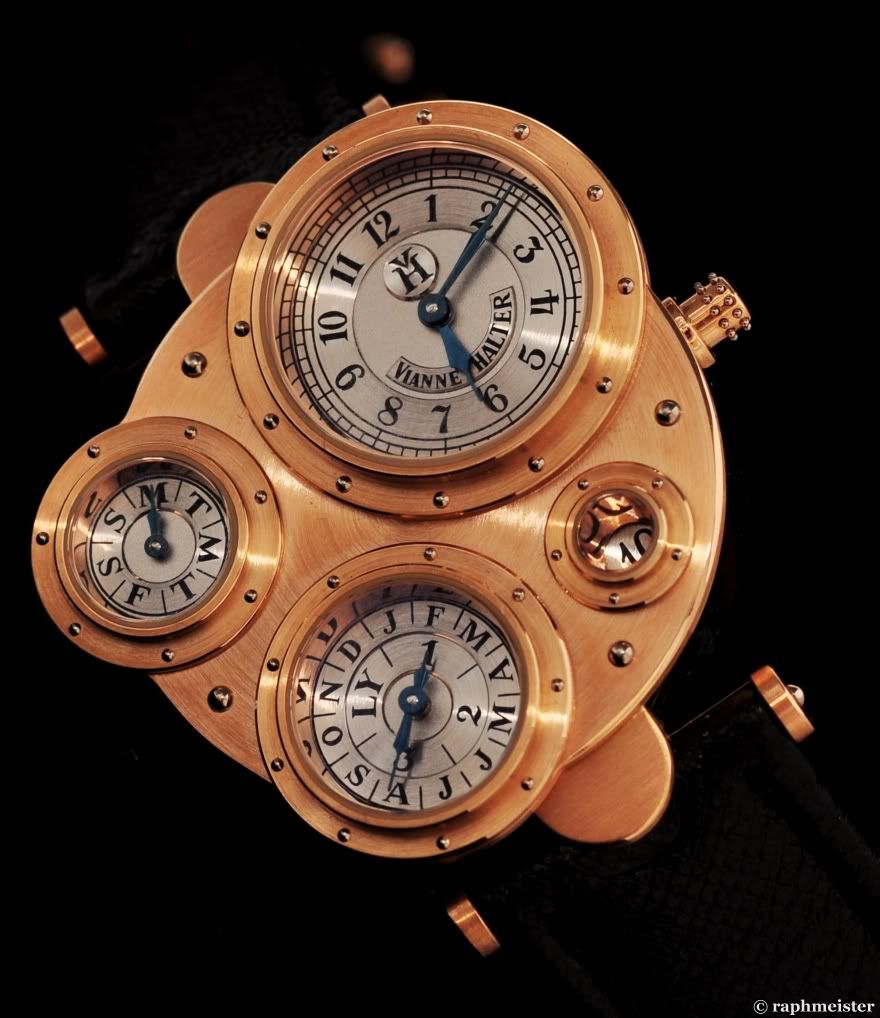
No comments:
Post a Comment